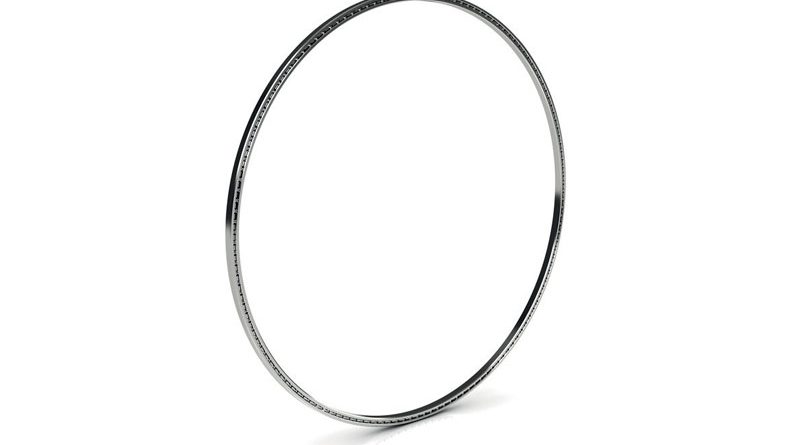Thin Section Bearings Provide Space and Save Weight
Today, component miniaturization is a strong trend in industry and bearings are no exception. Thanks to the compact envelope dimensions and lighter weight, thin section bearings better meet the demands of the robotic age.
by Joe Zagar
Today, the familiar internal geometries of the standard section, industrial ball bearing are available in a thin section version that provides space and weight savings of more than 80% in most applications (Fig 1).
Deep groove, angular contact, and type X
The internal geometry of ball bearings is available in the usual radial deep groove and radial angular contact for duplexing. Thin section bearings have an option not often found in conventional proportions, which can be the ultimate solution for many applications: the four point contact, type X ball bearing (Fig 2).
While angular contact bearings are often mounted together to form a duplex pair that accepts radial, thrust, and moment loads, a type X bearing can essentially combine these functions into one row of balls. This is accomplished through special grinding geometry of the inner and outer raceway.
In type X bearings, the groove profile in each race consists of two intersecting arcs of equal radius that meet, forming a peak in the plane of the ball centers. The geometry, best described as a Gothic arch, achieves four contact points around each ball. Because there’s contact on all four ‘sides’ of the groove, a simple row type X bearing can resist radial, thrust, and moment loading in one compact row of balls.
While the type X is a problem solver, the more conventional type C (radial, Fig. 3) and type A (angular contact, Fig. 4) bearings are also available in thin section versions, ideal for the lowest torque and most precision of applications. The use of multiple bearing supports improves the load rating of the finished design, just as it would with normal section bearings. Frequently, a duplex pair is combined with a radial support bearing at the other end to provide high deflection stiffness and load capability (Fig. 5).
Turning two bearings into one
In real-world applications, bearings are often subjected to a combination of loads. This means that one type X bearing – supporting radial, thrust, and moment loads at once – can often replace two bearings, be they angular contact ball bearings, tapered roller bearings, or a combination of thrust and radial bearings (ball or roller). (Fig. 6, 7, 8).
Constant cross sections available
Another convenience to the designer is the availability of cross section thicknesses that stay constant regardless of the bore size that is needed. This allows equipment such as pointing/tracking gimbal assemblies to maintain the same aspect ratio, even though multiple bearings are used to provide rotation functions (fig. 9, 10).
Precision enhancements
Thin section bearings are available in familiar ABEC precision grades. Tolerances are controlled to many of the same ABEC 1-7 grades. Additionally, thin section industry standards are set up to allow for extremely large diameters and the flexible nature of the inner and outer rings prior to final customer mounting. Precision enhancements such as low torque performance with honed race path finishing and hybrid ceramic ball options can provide customized performance beyond basic precision grades (fig. 11).
Space savings
Thin section ball bearings can provide many design advantages and options which would not normally be available in one anti-friction product. In many cases, the bulkiness of traditional ball bearings can be avoided without sacrificing capability. Example: Space savings of 85% and weight savings of 83% are achieved by choosing a thin section bearing instead of a 6010 standard ball bearing. The thin section bearing (below center) has a bore of 2.0 inches, is .25 inches wide and has 27 balls that are .125” in diameter, with a static axial capacity of 1,700 lbs (fig. 12).
(The even thinner ultra-thin bearing can offer even greater savings of up to 99.9% weight reduction and 97% volume reduction.)
For a small bearing that can fit in the palm of your hand, the thin section bearing carries an amazing amount of load. Good support (housing/shaft) distributes the load onto many balls, while still supporting the industry static limit of 609,000 psi Hertz stress at the heaviest loaded.
The ultimate solution for many applications
In a conventional bearing, loads are distributed across a few large-diameter rolling elements (balls). The thin section bearing features a compact design, using smaller and more numerous rolling elements spread over a larger area. This gives amazing load support and stiffness that rivals the performance of standard section bearings, while saving weight and opening up space (fig. 13). Thin section bearings offer load capacity that’s more than enough for many applications, while providing design flexibility and opportunities to reduce overall system size and cost. They are the ultimate solution for saving significant space and weight, while providing performance that’s similar to traditional standard bearings.
Joe Zagar is engineer at Kaydon Bearings, Muskegon, Michigan, USA.

